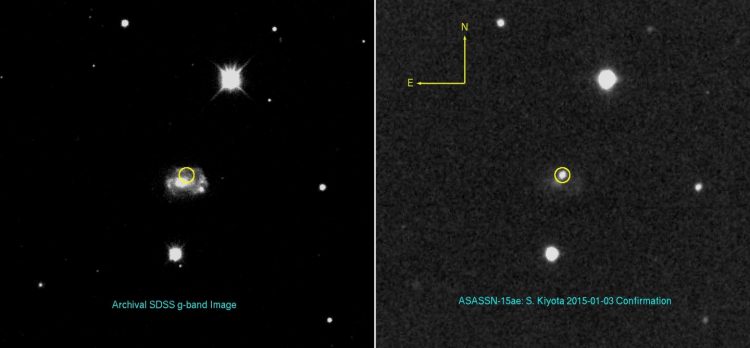'Assassin' targets supernovae in our neighborhood of the universe

On the left is a Sloan Digital Sky Survey archival image of a galaxy some 400 million light years away in which the All-Sky Automated Survey for Supernovae (ASAS-SN, pronounced 'assassin') detected a bright supernova on Jan. 3, 2015. On the right is an image submitted by ASAS-SN amateur contributor Seiichiro Kiyota of the Variable Star Observers League in Japan, which confirmed the existence of the supernova. Credit: ASAS-SN image courtesy of The Ohio State University
While many astronomical collaborations use powerful telescopes to target individual objects in the distant universe, a new project at The Ohio State University is doing something radically different: using small telescopes to study a growing portion of the nearby universe all at once.
The strategy is paying off. At the American Astronomical Society (AAS) meeting in Seattle this week, researchers reported early successes from the All-Sky Automated Survey for Supernovae (ASAS-SN, pronounced “assassin”).
Since it officially launched in May 2014, ASAS-SN has detected 89 bright supernovae and counting–more than all other professional astronomical surveys combined.
Right now, the survey consists of six 6-inch telescopes–four in Hawaii and two in Chile–and a cadre of telescopes volunteered by amateurs around the world. Two additional telescopes are set to go online early in 2015. And because the survey is capturing hundreds of other bright, local objects in addition to supernovae, Ohio State researchers are about to launch a series of spin-off projects, each geared to serve the growing interests of amateurs and professional astronomers alike.
ASAS-SN covers the nearest 500 million light years around the Milky Way Galaxy–about 1 percent of the observable universe, the edge of which is more than 46 billion light years away.
“It's natural to be interested in our local neighborhood. This is where we live, this is where the action is,” said Krzysztof Stanek, professor of astronomy at Ohio State.
“ASAS-SN is the only survey to study the local universe. Our early success proves that small telescopes can do big things, and the interest we've received from the astronomical community has quickly grown to the point that we need additional projects to cover other types of detection events besides supernovae.”
In particular, ASAS-SN has spotted more than 250 cataclysmic variables–stars that vary dramatically in brightness. At AAS, Ohio State doctoral student A. Bianca Danilet announced the launch of an ASAS-SN offshoot called the CV Patrol, which will track cataclysmic variable data from small telescopes online and in real time.
“This approach to looking at the nearby universe is proving successful in part because it's affordable, utilizes the efforts of highly motivated citizen scientists, and has the global reach necessary to spot these events and track them. It also just may provide information about the physics of these bright and transient phenomena that far-seeing telescopes cannot,” Danilet said.
Doctoral student Thomas Holoien agreed, adding that big telescopes are too sensitive to capture details of bright, nearby events. In that way, ASAS-SN complements the efforts of the big surveys. “We pick up where they leave off,” he said.
Aside from cataclysmic variables, ASAS-SN has picked up two nearby tidal disruption events–extremely rare sightings of what happens when a black hole captures a portion of a nearby star–and many M dwarf flares, which are believed to emanate from stars with extremely strong magnetic fields.
Even though all these bright events happen in our local neighborhood, nobody is sure exactly how often they occur, said Christopher Kochanek, professor of astronomy at Ohio State and the Ohio Eminent Scholar in Observational Cosmology. ASAS-SN gives astronomers a chance to learn more about these events by seeing them up close.
Because ASAS-SN discoveries are made public online (at http://www.
This work is primarily funded by the National Science Foundation and Center for Cosmology and Astro Particle Physics at Ohio State. Holoien is funded by the Department of Energy Computational Science Graduate Fellowship. Additional support came from the Mt. Cuba Astronomical Foundation and a private donation from retired Homewood Corp. CEO George Skestos. ASAS-SN telescopes are hosted by the Las Cumbres Observatory Global Telescope Network.
Contacts: Krzysztof Stanek, (614) 292-3433; Stanek.32@osu.edu
Christopher Kochanek, (614) 292-5954; Kochanek.1@osu.edu
[Stanek and Kochanek are not attending the AAS meeting. Email Danilet (Davis.4811@osu.edu) and Holoien (Holoien.1@osu.edu), or reach them through Pam Frost Gorder.]
Written by Pam Frost Gorder, (614) 292-9475; Gorder.1@osu.edu.
Media Contact
More Information:
http://researchnews.osu.eduAll latest news from the category: Physics and Astronomy
This area deals with the fundamental laws and building blocks of nature and how they interact, the properties and the behavior of matter, and research into space and time and their structures.
innovations-report provides in-depth reports and articles on subjects such as astrophysics, laser technologies, nuclear, quantum, particle and solid-state physics, nanotechnologies, planetary research and findings (Mars, Venus) and developments related to the Hubble Telescope.
Newest articles

Combatting disruptive ‘noise’ in quantum communication
In a significant milestone for quantum communication technology, an experiment has demonstrated how networks can be leveraged to combat disruptive ‘noise’ in quantum communications. The international effort led by researchers…

Stretchable quantum dot display
Intrinsically stretchable quantum dot-based light-emitting diodes achieved record-breaking performance. A team of South Korean scientists led by Professor KIM Dae-Hyeong of the Center for Nanoparticle Research within the Institute for…

Internet can achieve quantum speed with light saved as sound
Researchers at the University of Copenhagen’s Niels Bohr Institute have developed a new way to create quantum memory: A small drum can store data sent with light in its sonic…





















